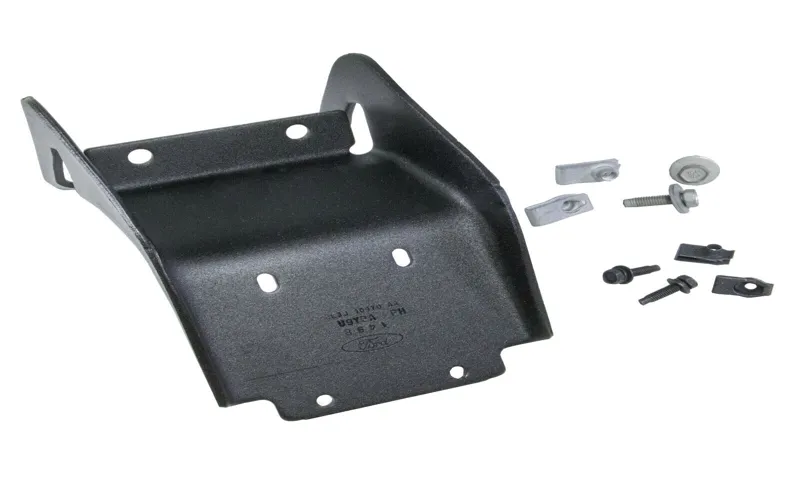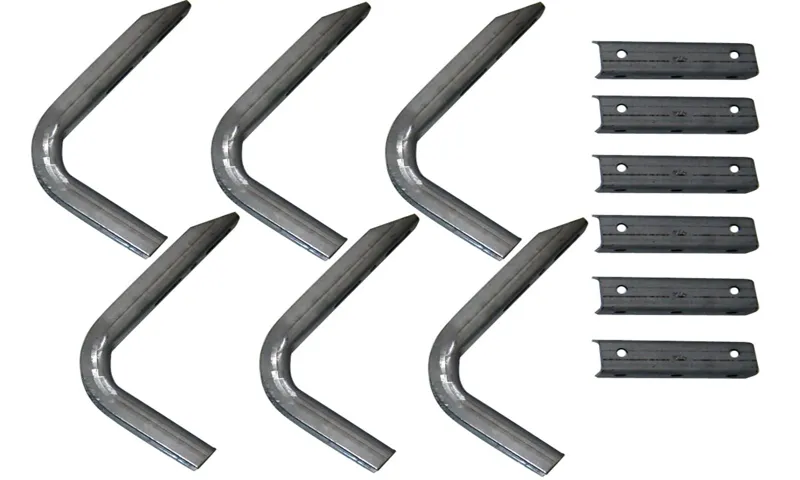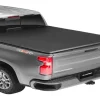So you’ve purchased a set of running boards for your vehicle to enhance its look and functionality. Now the next step is to mount those running boards securely to your vehicle frame. But how do you go about doing that? Don’t worry, we’re here to help you navigate through the process.
Mounting running board brackets to your vehicle frame may seem like a daunting task, but with the right tools and a little bit of know-how, you’ll be able to get it done in no time. Just like building a puzzle, each bracket is designed to fit a specific area of your vehicle frame, ensuring a secure and sturdy attachment. First things first, gather all the necessary tools for the job.
Depending on the make and model of your vehicle, you’ll generally need a socket wrench, a torque wrench, a drill, and possibly a wire brush. Once you have everything you need, it’s time to start the installation process. Begin by locating the mounting points on your vehicle’s frame.
These mounting points are typically found underneath the vehicle, near the rocker panels. If your vehicle already has existing factory mounting holes, you’re in luck. If not, you may need to create your own mounting holes using a drill.
Once you’ve located the mounting points, position the brackets on the frame in the correct orientation. Make sure the brackets align with the running board and that they are evenly spaced to ensure proper weight distribution. Using your socket wrench, secure the brackets to the frame by tightening the bolts or screws provided with your running board kit.
Remember to not overtighten, as it may cause unnecessary stress on the brackets or frame. After securing the brackets, take a step back and visually inspect the installation. Ensure that the brackets are straight and level, and that there is no wobbling or movement.
Table of Contents
Introduction
If you’re looking to mount running board brackets to your vehicle’s frame, it’s important to know where exactly to position them for optimal functionality and safety. The frame of your vehicle is a sturdy and reliable structure that can support the weight of running boards and the people stepping on them. Typically, the brackets should be mounted along the frame rails in areas where they won’t interfere with the operation of any components or obstruct other parts of the vehicle.
It’s a good idea to consult your vehicle’s manual or seek the advice of a professional technician to ensure the brackets are installed correctly. By properly mounting the running board brackets to the frame, you can enjoy the convenience and enhanced aesthetics they provide while ensuring the stability and longevity of your running boards.
Overview of running board brackets and their purpose
running board brackets, purpose. Introduction: Running board brackets are an essential component of a vehicle’s running board system. These brackets serve an important purpose, providing support and stability to the running board, which is the platform located along the sides of a vehicle.
The running board brackets are typically made of durable materials such as steel or aluminum, ensuring that they can withstand the weight and pressure placed on them. Without these brackets, the running boards would not be able to effectively serve their intended purpose of providing a convenient step and extra protection for the vehicle’s body. In this blog section, we will explore the specific functions and benefits of running board brackets, as well as the different types available in the market.

Importance of properly mounting the brackets to the vehicle frame
properly mounting the brackets Introduction: When it comes to vehicle modifications, it’s essential to ensure that everything is done correctly, and this includes mounting brackets. Mounting brackets play a crucial role in providing stability and support for various accessories and components attached to a vehicle. Whether it’s a light bar, a winch, or a roof rack, properly mounting the brackets to the vehicle frame is of utmost importance.
Not only does it ensure the safety of the vehicle and its occupants, but it also prevents potential damage to the accessories and the vehicle itself. In this blog, we will dive deeper into the importance of properly mounting brackets to the vehicle frame and the consequences of neglecting this crucial step.
Determining the Mounting Location
When it comes to mounting running board brackets to the frame of your vehicle, it’s essential to choose the right location. The mounting location will determine the stability and functionality of your running boards, so it’s crucial to get it right. To determine the mounting location, you need to consider a few factors.
First, you need to identify the spots on the frame where the brackets can be securely attached. Look for areas that are strong and sturdy enough to hold the weight of the running boards and withstand the impact of everyday use. Once you’ve identified these spots, you’ll need to measure the distance between them carefully.
This will help ensure that the running boards are properly aligned and provide sufficient clearance for your vehicle’s doors and wheels. Keep in mind that the mounting location may vary depending on the make and model of your vehicle, so it’s essential to consult the manufacturer’s instructions or seek professional advice if you’re unsure. With the right mounting location, your running boards will not only look great but also provide the functionality and support you need.
Identifying the suitable mounting points on the vehicle frame
When it comes to installing equipment or accessories on a vehicle, one of the most important steps is determining the mounting location. This is where the equipment will be secured to the vehicle frame, providing stability and ensuring it stays in place while the vehicle is in motion. There are several factors to consider when identifying the suitable mounting points on the vehicle frame.
Firstly, it’s crucial to assess the weight and size of the equipment to be mounted. This will help determine the structural integrity needed from the mounting location. Additionally, the vehicle’s make and model should also be taken into account, as different vehicles have different frame designs and strengths.
Another important aspect to consider is the accessibility of the mounting point, as it should be easily reachable for installation and maintenance purposes. Lastly, the mounting location should be chosen in a way that minimizes any potential interference with other components of the vehicle or the driver’s line of sight. Overall, identifying the suitable mounting points on the vehicle frame requires careful consideration of various factors to ensure a secure and efficient installation.
Considerations for different vehicle models and sizes
When it comes to determining the mounting location for a vehicle GPS tracker, there are a few key considerations to keep in mind, especially for different vehicle models and sizes. One important factor to consider is the visibility of the tracker. You’ll want to choose a location that allows for easy access and visibility, ensuring that it can be easily seen by the driver and doesn’t obstruct their view or distract them while driving.
Another factor to consider is the vehicle’s construction and dimensions. Different vehicle models and sizes may have different areas that are suitable for mounting a tracker. For example, smaller vehicles may have limited space, making it necessary to find a compact and discreet location for the tracker.
On the other hand, larger vehicles may have more options for mounting locations, but you’ll still want to choose a location that is secure and won’t get damaged or dislodged during normal driving conditions. Ultimately, the choice of mounting location will depend on the specific vehicle and its unique features, but by considering visibility, accessibility, and construction, you can find the right spot for your GPS tracker that meets your needs and ensures optimal tracking capabilities.
Using a measuring tape and level to ensure accurate placement
Determining the Mounting Location
Preparing the Vehicle Frame
When it comes to mounting running board brackets to a vehicle frame, it’s crucial to choose the right location to ensure stability and durability. The frame is the strongest part of the vehicle, so it’s important to find the spots where it’s structurally sound and can handle the weight of the brackets and running boards. One common location where you can mount the brackets is on the rocker panel of the frame.
This area is usually reinforced and can provide a sturdy base for the running boards. Another option is to mount the brackets to the frame rails, which run along the underside of the vehicle. These rails are designed to bear heavy loads and are ideal for supporting the weight of the running boards.
Keep in mind that each vehicle is unique, so it’s important to consult the manufacturer’s instructions or seek professional advice to ensure proper installation. So, take your time to select the right mounting location and enjoy the added convenience and style of running boards on your vehicle.
Cleaning and preparing the area where the brackets will be mounted
“Cleaning and preparing the area where the brackets will be mounted”
Removing any existing brackets or debris that may interfere with installation
When it comes to preparing your vehicle frame for installation, one crucial step is removing any existing brackets or debris that may interfere with the process. This ensures a smooth and secure installation of the new components you’re adding. Imagine trying to build a puzzle with pieces that don’t quite fit together because there are bits of old puzzle pieces in the way.
It would be frustrating and ultimately ineffective. Similarly, by removing any brackets or debris from your vehicle frame, you’re creating a clean slate for the installation process. This allows the new components to fit properly and function optimally.
So, take the time to clear away any obstructions and create a solid foundation for your vehicle’s upgrades. Your future self will thank you!
Applying a protective coating to prevent corrosion
When it comes to protecting your vehicle frame from corrosion, applying a protective coating is a crucial step. But before you can start coating, proper preparation is key. It’s like building a solid foundation before constructing a house.
So, let’s talk about how to prepare your vehicle frame before applying that protective layer. The first step is to thoroughly clean the frame. Remove any dirt, grease, or rust using a wire brush or sandpaper.
This will ensure that the coating adheres properly and provides maximum protection. Once the frame is clean, inspect it for any signs of damage or rust. If you notice any areas that are compromised, make the necessary repairs before proceeding with the coating.
Finally, make sure the frame is completely dry before applying the protective coating. Moisture can compromise the effectiveness of the coating, so take your time and ensure the frame is dry. By taking these steps to prepare your vehicle frame, you’ll be laying the groundwork for long-lasting protection against corrosion.
Mounting the Brackets
When installing running boards on your vehicle, it’s important to know where to mount the brackets to the frame. The location of these brackets is crucial for the stability and durability of your running boards. One common method is to mount the brackets to the frame using existing holes or slots, if available.
This ensures a secure and strong connection between the frame and the running boards. If there are no pre-drilled holes or slots, you may need to drill your own holes on the frame. It’s essential to choose a spot on the frame that is solid and can handle the weight and stress of the running boards.
Additionally, you want to ensure that the brackets are mounted evenly and aligned properly on both sides of the vehicle. This will not only make your running boards look aesthetically pleasing, but it will also distribute the weight evenly and provide maximum support. It’s always recommended to refer to the manufacturer’s instructions for specific guidelines on where to mount the brackets on your particular vehicle.
By following these instructions and taking the time to properly install the brackets, you can enjoy the added functionality and style of running boards on your vehicle.
Attaching the brackets to the mounting points on the vehicle frame
mounting the brackets, attaching brackets, vehicle frame Attaching the brackets to the mounting points on the vehicle frame is a crucial step in ensuring proper installation and stability for various equipment and accessories. The brackets serve as the connecting point between the vehicle frame and the desired accessory or equipment, such as a bike rack or a winch. They provide the necessary support and strength for securely holding the equipment in place while the vehicle is in motion.
Installing these brackets involves locating the appropriate mounting points on the vehicle frame, which can vary depending on the make and model of the vehicle. Once the mounting points are identified, the brackets are attached using bolts or screws, ensuring a tight and secure fit. It’s important to follow the manufacturer’s instructions and recommendations for torque specifications to prevent any damage or failure.
By properly mounting the brackets, you can have peace of mind knowing that your equipment is securely attached and ready for use.
Using the appropriate hardware and tools for secure installation
When it comes to securing and installing your hardware, using the appropriate tools and hardware is crucial. One important aspect of this is mounting the brackets. Brackets are used to hold and support different types of hardware, such as shelves, cameras, or even television mounts.
To ensure a secure installation, it is important to choose the right type of brackets and use the appropriate hardware. For example, if you are installing a shelf bracket, make sure to choose a bracket that is strong enough to hold the weight of the shelf and the items that will be placed on it. Additionally, using the right screws or anchors is essential for a secure installation.
Using the wrong screws or not installing anchors properly can result in a weak or unstable mount. So, take the time to choose the right hardware and tools for your specific installation needs.
Ensuring proper alignment and levelness of the brackets
When it comes to mounting brackets, ensuring proper alignment and levelness is crucial. This step is often overlooked, but it is essential for a secure and stable installation. Without proper alignment, the brackets may not be able to support the weight of the item being mounted, and they may even come loose over time.
To ensure proper alignment, first, mark the desired location for the brackets on the wall. Use a level to make sure the brackets are perfectly straight and even. If they are not, make any necessary adjustments before moving on.
Once the brackets are aligned, use a pencil or marker to mark the screw holes. This will serve as a guide for drilling. It’s also important to consider the weight of the item being mounted.
If it’s a heavy item, use anchors or toggle bolts for added support. By taking the time to ensure proper alignment and levelness, you can be confident that your brackets will provide a sturdy and secure mounting solution.
Final Steps and Considerations
So, you’ve purchased running boards for your vehicle and now it’s time to install them. One of the most important steps in this process is determining where to mount the running board brackets to the frame of your vehicle. This is crucial for ensuring a secure and sturdy installation.
Firstly, you’ll want to consult the instructions provided by the manufacturer of your running boards. They may have specific guidelines or recommendations for where to mount the brackets on your particular vehicle model. Following these instructions will ensure that you achieve the best fit and stability.
If the manufacturer’s instructions aren’t clear or don’t provide enough information, you can also consult with a professional installer or mechanic. They will have experience with installing running boards and can offer advice on the best placement for the brackets. When determining where to mount the running board brackets, it’s important to consider the weight-bearing capacity of your vehicle’s frame.
You want to choose a location that can handle the weight of the running boards and any additional weight they may bear, such as a person stepping onto them. This will help to prevent damage to your vehicle and ensure the safety of anyone using the running boards. Additionally, you’ll want to make sure the brackets are mounted in a way that won’t interfere with any existing components or systems on your vehicle.
Take a close look at the areas where the brackets will be mounted and ensure that they won’t obstruct any important parts or cause any potential issues. Overall, when it comes to mounting running board brackets to the frame of your vehicle, it’s important to follow the manufacturer’s instructions, consult with a professional if necessary, and consider the weight-bearing capacity and potential interference with existing components. By taking these steps, you can ensure a secure and successful installation of your running boards.
Testing the stability and durability of the installed brackets
brackets durability, stability testing, final steps, considerations, installed brackets stability, bracket testing, brackets strength, durability testing brackets
Applying additional protective measures, such as sealant or anti-vibration pads
In order to provide additional protection for your appliances, there are a few final steps and considerations to take into account. One option is to apply a sealant to the surfaces of your appliances, which can help to prevent corrosion and damage from moisture. This can be especially beneficial for appliances that are exposed to water, such as dishwashers or refrigerators with ice makers.
Another option is to use anti-vibration pads, which can help to minimize vibrations and reduce the risk of damage to your appliances. These pads are particularly useful for appliances like washing machines or dryers, which can create a lot of vibration during operation. By using these protective measures, you can extend the lifespan of your appliances and ensure they continue to operate at peak performance for years to come.
Regular maintenance and inspection of the brackets for longevity
brackets, regular maintenance, inspection, longevity, final steps, considerations
Conclusion
In the quest for the perfect running board placement, one might find themselves pondering the eternal question of where to mount those pesky brackets. Fear not, as I am here to shed some light on this matter with a twist of wit and cleverness! Picture this, dear reader: you’re standing in front of your trusty old chariot, ready to conquer the open road with style. But alas, you’re met with the conundrum of where to attach those running board brackets to the frame.
It’s a perplexing dilemma, indeed. Should you go for a high mount, giving your vehicle an air of grandeur? Or perhaps a lower mount, allowing for easier access and a touch of practicality? Well, fear not, for the answer lies within the realms of both strategy and aesthetics. You see, mounting those brackets too high may result in a running board that looks more like a diving board.
We don’t want your vehicle to become an impromptu Olympic stage, do we? On the other hand, a lower mount might make your beloved four-wheeled companion resemble a turtle carrying some sort of peculiar shell. We wouldn’t want your car to suffer an identity crisis now, would we? Besides, who wants to be reminded of tortoises when cruising down the highway? So, my wise and witty friends, the secret lies in finding the perfect balance. Imagine yourself as a master architect, carefully considering the angles, proportions, and functionality of your vehicle.
Seek inspiration from the great designers of our time, for they understand the importance of harmony between form and function. Think about it: a running board that strikes the perfect balance between style and practicality, showcasing your vehicle’s personality while serving its purpose. It’s a magical union that can only be achieved by mounting those brackets in the Goldilocks zone – not too high, not too low, but just right.
In conclusion, my clever comrades, the answer to the age-old question of where to mount running board brackets to the frame lies within the realm of balance. Find that sweet spot, and your vehicle will thank you, your passengers will marvel, and the envy of all other drivers will be yours. So go forth, mount those brackets, and let your running boards become the envy of the road!”
FAQs
Where should I mount the running board brackets to the frame of my vehicle?
The running board brackets should be securely mounted to the frame of your vehicle for optimal stability and support. It is recommended to consult your vehicle’s owner’s manual or contact the manufacturer for specific instructions on where to mount the brackets.
Are there any specific guidelines on mounting the running board brackets to the frame?
While the exact mounting instructions may vary depending on the make and model of your vehicle, there are some general guidelines to follow. Ensure that the brackets are positioned evenly on both sides of the vehicle and mounted securely to the frame using appropriate hardware. It is important to take into consideration any wiring or other components that may interfere with the installation process.
Can I mount the running board brackets directly onto the frame without any additional support?
In most cases, it is recommended to use additional support brackets or hardware when mounting the running board brackets to the frame. This helps distribute the weight evenly and ensures a more secure installation. Using additional support can also prevent the brackets from flexing or bending over time, increasing the longevity and stability of the running boards.
How do I determine the correct placement for the running board brackets on the frame?
The correct placement of the running board brackets will depend on the design and dimensions of your specific vehicle. It is important to carefully measure and mark the desired location on the frame before drilling any holes or mounting the brackets. Consult the installation instructions provided by the running board manufacturer or seek professional assistance if needed.
Are there any safety precautions I should take when mounting the running board brackets?
Yes, there are a few safety precautions to keep in mind while installing the running board brackets. Use safety glasses and gloves to protect yourself during the installation process. Make sure the vehicle is securely supported on jack stands or a lift before working underneath it. Follow all manufacturer-recommended procedures and guidelines to ensure a safe and successful installation.
Can I install running board brackets on a vehicle without a frame?
Some vehicles, such as unibody construction vehicles, may not have a traditional frame. In these cases, it is important to consult a professional or the manufacturer to determine the best way to install running board brackets. They will be able to provide guidance on alternative mounting methods, such as utilizing structural points on the vehicle’s body or frame reinforcement.
Can I install running board brackets on a vehicle with aftermarket modifications?
Installing running board brackets on a vehicle with aftermarket modifications may require additional considerations. It is important to ensure that the modifications do not interfere with the installation process or compromise the structural integrity of the vehicle. Consulting with a professional or the manufacturer will help determine the best course of action for installing the running board brackets safely and securely.



